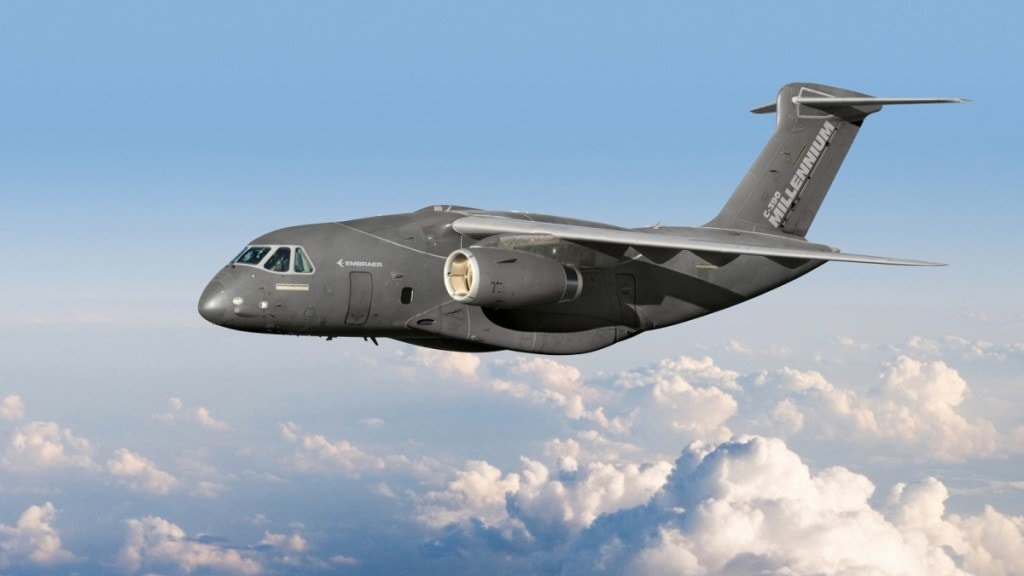As India intensifies efforts to bolster its defence capabilities, two significant procurement decisions are generating considerable interest: the ongoing deliberations over Embraer’s C-390 Millennium for India’s Medium Transport Aircraft (MTA) requirements and the revived Multi-Role Fighter Aircraft (MRFA) program, now attracting international bidders from Boeing to Saab. These procurements highlight India’s ambitions for a robust and modernised military force, even as the nation carefully navigates the geopolitical implications of its choices.
C-390 Millennium: Boosting Transport Capacity with Indigenous Collaboration
Earlier this year, Embraer and Mahindra Defence Systems entered into an agreement to produce the C-390 Millennium transport aircraft locally. The deal marked a strategic alignment with India’s Atmanirbhar Bharat, or “self-reliant India” initiative, a directive aimed at reducing the country’s dependence on foreign defence suppliers and fostering domestic production capabilities. Embraer’s C-390, a versatile multi-mission aircraft known for its efficient cargo and medevac capabilities, is viewed as a potential replacement for India’s aging fleet of Soviet-origin aircraft.
The partnership with Mahindra Defence enables India to capitalise on advanced foreign technology while maintaining a level of sovereignty in production, offering Embraer the opportunity to solidify its presence in one of the world’s fastest growing defence markets. If successful, this collaboration could set a precedent for future foreign partnerships that align with India’s Make in India strategy, reinforcing the country’s ability to manufacture and maintain critical defence assets.
MRFA Program: A High-Stakes Decision in Multi-Role Fighter Selection
India’s MRFA program, revived with fresh momentum, represents one of the most ambitious fighter procurement efforts globally, potentially bringing in 114 new aircraft to replace its retiring MiG-21 fleet. Contenders include Boeing with the F-15EX and F/A-18 Super Hornet, Lockheed Martin’s F-21 (an India-specific variant of the F-16), Sweden’s Saab Gripen, Dassault’s Rafale, and even Russia’s MiG-35.
The competition, while reminiscent of India’s previous Medium Multi-Role Combat Aircraft (MMRCA) contest, has gained fresh geopolitical dimensions. Lockheed’s F-21 pitches are centered on India-US defence ties, promising a capable platform with extensive operational history. Lockheed’s proposal further leverages America’s industrial strengths, including joint ventures and offsets to ensure high domestic content. In addition, the F-21’s compatibility with the Indian Air Force’s existing systems and infrastructure could reduce logistical complexities and long-term costs.
Conversely, Saab’s Gripen has positioned itself as a more cost-effective choice, offering technology transfers and localised production. The Gripen’s compact design and agility, along with advanced avionics, have appealed to the IAF’s tactical needs, while Sweden’s neutral geopolitical stance could offer India an additional layer of strategic flexibility. Sweden’s recent decision to select the C-390 for its own transport needs may also strengthen defence ties, providing a foundation for potential cross-sector collaboration.
The Geopolitical Calculus: Balancing Defence and Diplomacy
Amid this competitive landscape, India’s decision-making is increasingly influenced by broader political factors. The nation’s strategic pivot towards stronger partnerships with the U.S. has underpinned discussions on procuring American platforms, while longstanding defence relations with Russia add further complexity. The MRFA and MTA procurements are not just about technical specifications or costs; they are also about sustaining defence partnerships that bolster India’s regional security posture.
The unpredictable trajectory of U.S. foreign policy, with potential changes in administration in the near future, complicates matters. Former U.S. President Donald Trump’s administration saw a closer alignment with India, but his uncertain future in U.S. politics leaves India weighing the stability of its ties with American defence companies against possible shifts in policy. Saab’s Gripen, by contrast, is less exposed to the vicissitudes of U.S. domestic politics, but Sweden’s defence industry lacks the same global production scale and logistical support as Lockheed or Boeing.
India’s Path Forward: Towards Strategic Autonomy
India’s drive for defence self-sufficiency has seen it balancing foreign collaborations with an increasing focus on indigenous manufacturing. The Indian government has announced policies to encourage domestic defence production, aiming to ensure that up to 60% of the components for any imported system are sourced locally. Initiatives such as the development of the Advanced Medium Combat Aircraft (AMCA) underscore India’s desire to become self-reliant in critical defence technology over the next decade.
The question now facing Indian defence officials is whether they can achieve a balance between indigenous development and foreign partnerships that maximizes capability without compromising on autonomy. If India opts for the C-390 and the Gripen, it could strengthen its independent production capabilities while expanding ties with non-aligned nations. Conversely, opting for Boeing or Lockheed platforms might expedite modernisation but bind India more closely to U.S. supply chains, with potential trade-offs in strategic autonomy.
An Era of Strategic Decisions
For India, the stakes are high. As geopolitical tensions continue to rise in the Indo-Pacific and beyond, the nation’s procurement choices will resonate beyond the confines of military capability. These decisions will shape India’s role as a regional power, its ability to safeguard its borders, and its strategic autonomy in an increasingly multipolar world. Both the Embraer-Mahindra partnership and the MRFA contest illustrate India’s nuanced approach to defence modernisation—a journey of balancing partnerships, fostering local industry, and safeguarding sovereignty.

